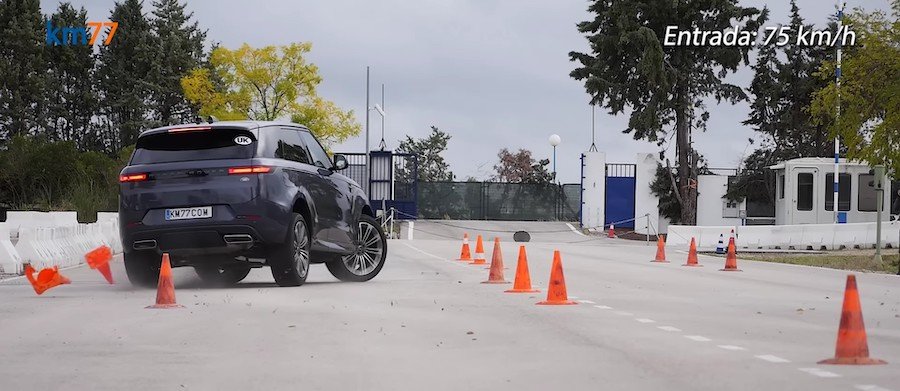2023 Range Rover Sport Makes a Fool of Itself in 48-MPH Moose Test

So, if one such behemoth was to perform a sudden evasive maneuver at, let's, say 48 mph (or 77 kph), you wouldn't expect it to perform Olympically. Especially when the three-ton mass comes into play, which is a lot for passenger cars standards. That figure knocks at the industrial equipment doors, but with plush creature comforts in the cabin, minus the bulldozing capabilities.
However, the Range Rover has a sportier version, called – rather bluntly – the Range Rover Sport. Stiffer suspensions, better handling, better engine, and still rhino-like road demeanor. The Spaniards from the Km77 auto magazine put the model through the famous – and infamous – Moose Test. The results are… well, read on, and you decide whether the outcome is a success or less.
First off, the Moose Test does not involve any moose. It draws its name from the long-legged, ill-tempered cervid that occasionally – read "obtrusively" – decides to plant its massive body on highways. This is not a metaphor, as Swedish carmakers came up with this combined method of car testing exactly because close animal-automobile encounters were too often on the Scandinavian highways. Drivers from Canada and the northern U.S. states can back this up, too.
Conceived in Sweden – it's a safety test, so where else? – the test is relatively simple: drive at a certain speed, yank the steering wheel to the left all of a sudden to avoid an obstacle, pass said obstruction, steer right, and put the car back on its road. It sounds simple, but certain limitations apply for a vehicle to be deemed a passing score.
First off – the initial speed. In the case of Km77 magazine, the velocity is 77 kph (or the 48 mph stated above). Then, the sudden detour must be confined to certain distances for each maneuver involved (see the gallery for the technical details). And lastly, the car needs to stick to the course without losing control or running over the delimiting cones.
This a popular way to test a vehicle's stability, cornering, braking, and driver aids. And depending on several influencing factors, the test can prove too hard for certain automobiles. One is the Range Rover Sport – the plug-in hybrid variant – which can not outmaneuver the obstacle at the required speed.
Despite its all-wheel steering and the plethora of braking and stability assistance systems, the bulk of the Range Rover Sport is too much. Physics does not bow to mechanical advancements all the time, after all.
The car – a 2023 Range Rover Sport P510e Autobiography - has a three-liter inline-six engine. Together with the socket-sucker 105 kW motor, the powertrain puts 503 hp (510 ps) on all four wheels, spinning under the "Torque Vectoring Braking" rule.
In Range Rover's marketing bragging words, this "delivers responsive, controlled cornering and handling through even the tightest of bends. The electronic differential and vehicle's braking system constantly balance the distribution of engine torque between the four wheels."
The small print should say that the mechanical magic runs out at around 43 mph (69 kph) – above that, the sporty Brit loses its cool and way and fails the test. The video is beyond objection – the car is too heavy to stay on the road safely.
The hidden downside of hybrid-ification is the added battery – taking the gross weight to 6,680 lbs. (3,030 kg, for metric accuracy). That's a lot to handle, even for high-priced sophistications such as air suspensions, torque vectoring braking, all-wheel-drive, all-wheel-steering, and whatnot.
The highest safe speed was 43 mph (69 kph). At just one extra mile per hour, the luxury SUV cocks its inside rear wheel during braking, copiously understeers, and smashes a few cones flat. That road behavior is disappointing for a car that costs around $140K – and keep in mind that the P510e Autobiography variant is not for sale in America.
Some gearheads might argue that the all-weather/all-season 32-inch Pirelli tires fitted on the test car are not optimal for this type of maneuver, even at 11 inches wide (285 mm). Then again, Pirelli came up with the "Power is nothing without control" slogan some decades ago, they should know about the rubber they're making.
The result is not surprising, considering that the Sport's bigger brother – the Range Rover PHEV– also failed this test (but worse). Depending on which side you see this from, it's either a lose-lose situation or a bad-and-not-so-bad dilemma. Either way, drive slower - you'll avoid the moose, PETA, and all the pain-in-the-rear-bumper-related conundrums.
Related News
